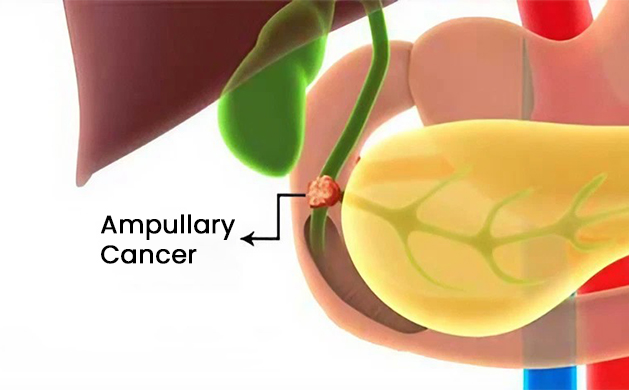Ampullary cancers are rare, affecting only 0.2% of gastrointestinal cancers and around 7% of all periampullary cancers. It is a cancer that forms in the ampulla of Vater. The ampulla of Vater is referred to as a small opening that enters into the first part of the small intestines, called the duodenum. The ampulla of Vater is a place where the pancreatic and bile duct releases their body secretions into the intestines.
About Ampullary cancer
Ampullary cancer, also known as ampullary adenocarcinoma, begins with the growth of cells in the ampulla of Vater, where the common bile duct (CBD) and pancreatic duct combine and empty into the small intestine. It is necessary to differentiate ampullary carcinoma from periampullary cancer, such as extra biliary or pancreatic tumors, because of the wide variation in research studies. For example, pancreatic cancers and biliary tract carcinomas are related to significantly worse prognosis with limited treatment options as compared to ampullary cancers, even at early stages.
Ampullary cancer arises in the periampullary area. The term periampullary surrounds any of the four elements from this region. The common bile duct (CBD), pancreas ampulla, and duodenum. The type of cancer forms near other parts of the digestive system, including the liver, pancreas, and small intestine. The growth of ampullary cancer may affect these other organs.
The treatment often involves surgery to remove the cancer. This may include chemotherapy and radiation therapy to kill cancer cells. Ampullary cancer symptoms may include diarrhea, abdominal pain, blood in the stool, clay-colored stools, diarrhea, vomiting, weight loss, and jaundice. Fix an appointment with a healthcare provider if you have persistent symptoms that become worrisome.
Causes
Scientists and healthcare experts believe most ampullary cancers arise spontaneously; they are not usually because of lifestyle factors, family history, or other possible risks. Data revealed ampullary cancer is commonly diagnosed in people who are in their 70s. However, healthcare professionals found some connections with certain health conditions. So, these periampullary cancer causes include hereditary polyposis syndrome and hereditary nonpolyposis colorectal cancer, which may increase your risk of ampullary cancer.
Ampullary cancer causes include:
Hereditary polyposis syndrome increases the probability of an individual’s developing polyps in their digestive system. The presence of polyps can increase an individual’s risk of colorectal cancer.
Hereditary nonpolyposis colorectal cancer maximizes an individual’s risk of developing colorectal cancer where polyps are absent or, if present, they are smaller in size. Having either of these health problems can increase the risk of ampullary cancer for sure.
Ampullary cancer staging
Healthcare professionals apply the TNM system to diagnose periampullary carcinoma. This system gives concrete information about the cancer, such as its size and whether it’s spread to other body parts.
The TNM staging system involves the following:
-
- T (tumor): This defines the size of the tumor.
- N (node): This explains whether cancer has been in the lymph nodes.
- M (metastasis): Metastasis means the spreading of other parts of the body.
Together, these three elements of the TNM system give a clearer view of a patient’s ampullary cancer stages and help to identify appropriate treatment options. In metastasis, it spreads to the liver or abdominal lymph nodes. Research says ampullary cancer is less aggressive as compared to other cancer types that affect the head of the pancreas.
Treatments
The treatment of Ampullary cancer depends on the stage of the cancer. Ampullary cancer stages involve:
-
- Stage 1: where the cancer has not spread to nearby areas and is only in the inner layer of your small intestine.
- Stage 2: The can has spread to the middle layer of the small intestine and the muscular ring around the ampulla of Vater.
- Stage 3: Now, the cancer has spread to the outer wall of the small intestine.
- Stage 4: Ampullary cancer stage 4 is life-threatening as the cancer spreads to other areas of your body such as lymph nodes, liver, or pancreas.
Because the type of cancer is rare, there is not much information available to healthcare providers related to the efficacy of different ampullary cancer treatments. Most treatment options involve a combination of surgery and chemotherapy. Healthcare professionals also suggest radiation to shrink or destroy a tumor, but this treatment is less common.
Your healthcare team will suggest a treatment plan based on the cancer type, personal preferences, and any pre-existing health conditions. Commonly recommended treatments include:
Surgery:
Surgery is the only permanent solution used to remove the malignant tumor. Surgical resection with pancreaticoduodenectomy, called a Whipple procedure, is quite a complex surgical procedure that removes part of the pancreas and small intestine.
Chemotherapy:
For ampullary cancers that have spread to the lymph nodes, chemotherapy is recommended either after surgery or as a stand-alone therapy. The treatment involves the use of drugs, usually given intravenously, to kill cancer cells.
Radiation therapy:
To those with a high risk of cancer recurrence, healthcare professionals may recommend radiation therapy after surgery. This cancer treatment involves using high-energy X-rays to target and destroy cancer cells.
Survival rate
Ampullary cancer is considered a life-threatening disease, and the survival rate decreases as the cancer stages progress. According to research studies, there is an average five-year ampullary cancer survival rate of 30 to 67 % after surgery. However, the average survival rate varies from one person to another. The rates may also be affected by cancer subtypes and overall health. Here, survival rates must only be estimated numbers. They can’t tell how patients will respond to the treatment or how long they will live. To get a clearer view of survival rates for ampullary cancer, speak to your healthcare provider.




